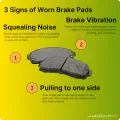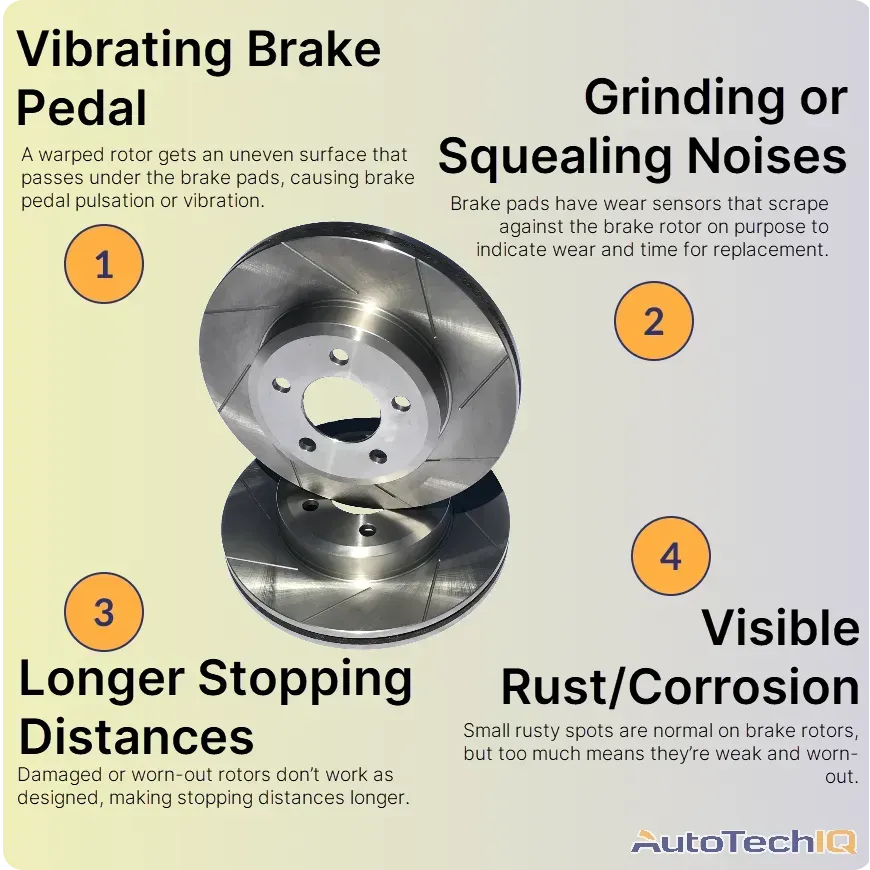
Truly, what are brake rotors? Brake rotors, often called discs, are critical components in a vehicle's brake system. They are flat, round metal discs that sit inside the wheel. When you press the brake pedal, brake pads squeeze against these rotors, creating friction. This friction slows down the wheel, allowing the vehicle to stop.
Over time, rotors can wear out or become warped due to heat, requiring inspection and sometimes replacement to keep up braking performance. Drilled and slotted rotors can become dangerous and even affect other braking components.
What are brake rotors made of?
Brake rotors are primarily made from iron, specifically cast iron. This material is used for its excellent heat dissipation properties, durability, and cost-effectiveness. So, the rotor can endure the friction heat during braking.
Some high-performance or specialty vehicles might utilize composite or carbon-ceramic rotors, which offer more performance and reduced weight but at a higher cost. These rotors can even endure more heat than regular ones.
What are brake pads, and how do they relate to rotors?
Brake pads and rotors are fundamentally linked in a disc braking system. Brake pads squeeze against the brake rotors when the brake pedal is pressed; they are also made with friction-resistant materials.
The rotors are flat, round metal discs attached to the wheel hub. When you press the brake pedal, some hydraulic pressure pushes the rotor and pad against each other, generating heat.
The car's movement is considered kinetic energy, and both the brake rotor and pad "absorb" this energy by generating heat; it kind of converts the movement into heat. Finally, with no more kinetic energy, the car stops moving.
What do "hot spots" mean on brake rotors?
Hot spots on brake rotors are areas that have received excessive heat. This issue often happens due to irregularities in the brake pad material or uneven rotor surface. These hot spots are discolorations on the rotor's surface, commonly blue, purple, or brown. Additionally, they may have a shiny or glazy appearance.
In addition, they can cause the rotor to warp, leading to pulsations in the brake pedal, lower braking efficiency, and potential steering vibrations.

What are the best brake rotors?
The "best" brake rotors depend on the vehicle's purpose and use. For daily drivers, high-quality cast iron rotors from reputable brands are enough. Alternatively, for performance or heavy-duty purposes, we recommend drilled, slotted, or carbon-ceramic rotors. Choosing rotors that match the vehicle's needs and specifications is essential for safety and durability.

Why are brake rotors thick?
Rotors are thick to dissipate the heat they generate during braking better. A thick disc brake figure allows them to absorb and release heat without warping or failing. A thicker rotor also provides a larger surface area for the brake pads to grip, improving brake performance. Over time, rotors wear down, losing thickness. In this case, maintaining a certain grip area is crucial for the brakes, and thicker rotors can achieve that.
What symptoms indicate a brake rotor failure?
Vibrating Brake Pedal
When pushing the brake pedal, a warped rotor can cause it to pulsate or vibrate. This is due to the uneven surface of the rotor bumping on the brake pads, resulting in a weird braking force.
Grinding or Squealing Noise
When brake pads wear down, they might have crooked wear patterns, which can scrape against the rotor. Alternatively, the pads might also become partially stuck, depending on their degradation. Consequently, you'll notice a grinding or squealing sound. Note that brake pad issues can even trigger the brake light on the dashboard.
Deep Grooves or Bends on the Rotor
Over time, debris or worn brake pads can overly damage the rotor's surface, causing noticeable grooves or bends. This shows up during a visual inspection and suggests the drilled rotors are wearing unevenly or are damaged. Typically, a rotor replacement is the main recommendation in this case.

Longer Stopping Distances
Damaged or worn-out rotors reduce the efficiency of the braking system, leading to increased stopping distances. At this stage, braking during high speeds can take longer and cause the vehicle to shake.
Steering Wheel Vibration
If a front rotor is warped or damaged, it causes the steering wheel to shake or vibrate. This pulsation can happen even while driving, but it's more common when braking.
Poor Brake Response or Fading
Rotors that have developed hot spots or are overheated can lead to brake fade, where the brakes become less effective after repeated hard stops. So, after an urgent brake, you'll notice a huge performance drop if you try to brake it again quickly.
Visible Rust or Corrosion
A thin layer of rust on a rotor after rain or washing is normal and usually gets cleared off naturally. However, excessive rust or deep corrosion affects the rotor's function and might indicate a need for replacement.

What a Class-act Brake Rotor Service Looks Like
Experienced technicians make it a journey of educating a car owner on every service. In this case, a class-act shop would go through the importance of brake rotor replacement and maintenance.
Inspect: The service starts with mechanics carefully inspecting the customer's vehicle. Then, they remove the wheels and place the car on a lift. Using a flashlight, the brake rotors are closely examined. In this example, the mechanics found deep groves and wear signs on the vehicle's brake rotors. Then, they took clear pictures of the damaged areas of the rotor.
Test: Next, the mechanic selected the best pictures to show the customer the inspection findings on a computer screen. Worn rotors can look quite messy and might startle some customers. But, it's the mechanic's job to explain how these grooves and scores affected the braking performance, causing vibrations and reduced stopping power.
Evaluate: Next, the mechanic conducted a brake pedal test on the customer's car. They invite the customer to press the brake pedal and notice the pulsations and vibrations transmitted. Then, the mechanic explained that these symptoms directly resulted from the damaged rotors.
Diagnose: With a precise diagnosis and visual evidence, the mechanic recommended a brake rotor replacement. They explained that replacing the rotors with new ones restores proper braking performance, eliminating vibrations and enhancing safety.
Confirm Repair is Done: The mechanic did the brake rotor replacement with the customer's consent. So, they carefully installed the new rotors, ensuring torquing and seating them correctly. The mechanic did another brake pedal test after bleeding the brake system to remove air. This time, the customer felt a significant difference—no more vibrations or pulsations. The brakes felt solid and responsive.
The main point of this type of service is to provide the customer with an understanding of the importance of brake rotor replacement. The technician's transparent inspection, clear communication, and image guidance made a routine maintenance task become a valuable lesson. The customer leaves the shop with a well-maintained vehicle and new knowledge, confident that his brakes are now in top-notch condition.
Top 5 Causes of Brake Rotor Symptoms:
Wear and Tear:
Gradual wear of brake rotors due to friction with brake pads leads to thinning, grooves, or uneven surfaces that affect braking performance.
Overheating:
Excessive heat generated during heavy or prolonged braking can warp brake rotors, causing vibrations and pulsations during braking.
Rust and Corrosion:
Exposure to moisture and road salt can result in surface rust and corrosion on brake rotors, affecting their smooth operation and causing noise.
Uneven Brake Pad Wear:
Uneven wear patterns on brake pads can transfer onto the rotor surface, creating grooves or high spots that lead to vibrations and reduced braking effectiveness.
Low-Quality Brake Pads:
Using low-quality or contaminated brake pads can accelerate rotor wear, causing premature damage and resulting in symptoms like noise and reduced performance.
Identifying and addressing these common causes of brake rotor symptoms is essential for maintaining safe and efficient braking in a vehicle.
Top 5 Brake Rotor Fixes:
Brake Rotor Replacement:
Remove worn or damaged rotors and install new ones to restore proper braking performance and eliminate issues like vibrations and noise.
Brake Rotor Resurfacing:
Machining the rotor surface to remove imperfections, grooves, and scoring, restoring a smooth, even contact surface for the brake pads.

Brake Pad Replacement:
Installing new brake pads to ensure even wear and prevent rotor damage, improving overall braking effectiveness.
Anti-Rust Treatment:
Applying anti-rust coatings or treatments prevents surface corrosion on the rotors, preserving their integrity and reducing noise.
Upgraded Brake Rotors:
Installing performance or high-quality brake rotors, such as slotted or drilled rotors, for improved heat dissipation and durability, reducing brake issues over time.
Summary
Brake rotors play a vital role in a vehicle's braking system. When worn out, drivers might notice a pulsating brake pedal, hear grinding noises, or observe deep grooves on the rotor. Extended stopping distances, vibrations in the steering wheel, poor brake response, and visible rust also hint at rotor issues. Regular inspection and maintenance ensure rotors function optimally and avoid damage to related brake components, like brake calipers.
There's an auto shop near you delivering fair, transparent service like you've read here.
Feel free to visit our 'Shop Near You' page and search for our certified repair shops in your area. These businesses provide top-notch services and expert inspections using advanced diagnostic tools. You'll witness the same level of care and attention to detail highlighted in this article. These shops share our goal of ensuring your vehicle receives the best possible maintenance. At this goal's core, your knowledge of what's happening to your car and how to maintain it is our #1 priority.
FAQ on Brake Rotors
1. What are brake rotors, and what do they do?
Brake rotors are round metal discs attached to your wheels. When you hit the brakes, your brake pads press against the rotors to slow the car down. No rotors, no stopping.
2. How do I know if my rotors are bad?
Look out for shaking or vibrations when braking, a grinding or squealing sound, or if it takes longer to stop than usual. Sometimes you’ll also feel a pulsing in the brake pedal.
3. Can I drive with bad rotors?
You can, but it’s not smart. Bad rotors mess with your stopping power. In an emergency, your brakes might not respond fast enough — and that could be the difference between a close call and a crash.
4. What causes rotors to go bad?
Mostly wear and tear. Every time you brake, the pads rub the rotors and wear them down. Heat, rust, and hard braking make it worse. Over time, they can get warped, grooved, or too thin.
5. How long do rotors usually last?
Depends on how you drive, but usually 30,000 to 70,000 miles. If you brake hard a lot or drive in stop-and-go traffic often, they’ll wear out faster.
6. What’s the difference between replacing and resurfacing rotors?
Resurfacing means smoothing out the old rotor to make it flat again — but that only works if it’s still thick enough and not badly damaged. If it’s too worn, warped, or cracked, it needs to be replaced.
7. How much does it cost to replace brake rotors?
It usually costs $200–$400 per axle, including parts and labor. Higher-end cars can cost more. Some shops recommend changing the pads at the same time to keep everything working smoothly.
8. Should I replace all rotors at once?
You don’t have to do all four, but you should at least replace them in pairs — front or back — so your braking stays balanced. Uneven brakes can mess with how your car handles.
9. What happens if I ignore worn rotors?
It gets dangerous. Your car might pull to one side, shake, or take longer to stop. Eventually, metal will grind on metal, damaging other parts and turning a cheap repair into an expensive one.
10. Can I tell just by looking at them if they’re bad?
Sometimes. If they look rusty, cracked, deeply grooved, or blue-colored from heat, that’s a red flag. But the thickness and feel matter too — a mechanic can measure them properly.
Other news
-
Car is Squealing When Driving

-
What is Preventative Maintenance and What Are The Benefits of it?

-
JobViewIQ - DVI Process Training - Part of the Auto Care Alliance Benefits

-
7 Signs of Clogged AC Components
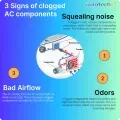
-
How Much Does a Transmission Fluid Change Cost?
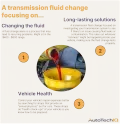
-
7 Signs of a Leaking Axle Seal
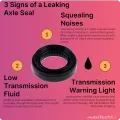
-
8 Signs of a Bad Brake Pad
